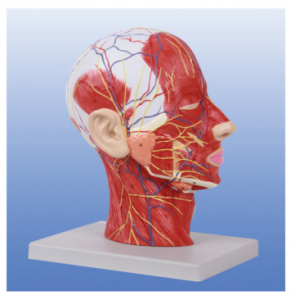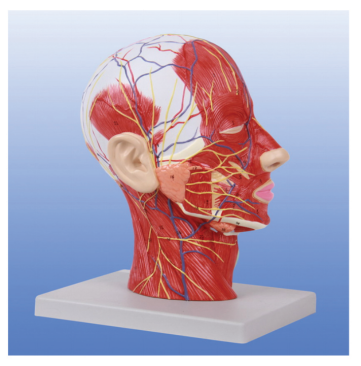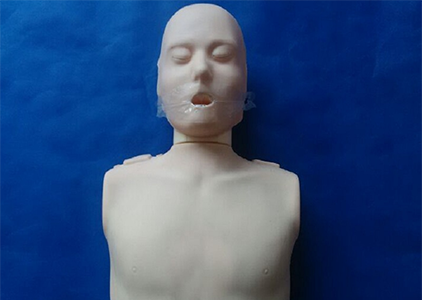
The neurovascular model of the head and neck can visually display a variety of key structures and tissues, providing students, physicians, and medical researchers with an in-depth understanding of the anatomy of the head and neck. The following are the main structures that the model can visually display:
Vascular system:
Basal cerebral arteries: The model clearly shows the arteries at the base of the brain, which provide vital blood supply to the brain.
Common carotid artery: The main artery of the neck, and the model usually has a clear indication of its direction and distribution.
Vertebral artery: Another important artery that supplies blood to the brain and is usually represented in the model.
Internal and external carotid arteries and their branches: These arteries have a complex distribution in the neck, and their position and direction can be clearly marked on the model.

Nervous system:
Trigeminal nerve: Located around the facial nerves, it is essential for facial sensory and motor function.
The sympathetic trunk and vagus nerve are located in the neck and are involved in regulating a variety of physiological processes.
Cranial nerves: Including multiple cranial nerves, their movement and distribution in the head and neck will also be reflected in the model.
Lymphatic system:
The model may also show the major lymph nodes in the neck, which play an important role in the immune response.
Skull and neck bones:
The names of each part of the skull, cranial suture, fontanel, etc. are indicated in the model.
Neck bones, such as the cervical spine, also show their structure and position in the model.
Muscle tissue:
The model may include some muscles of the head and neck, such as the sternocleidomastoid muscle, the trapezius muscle, etc., showing their shape and position.
Other structures:
Meninges: These include the dura, arachnoid, and pia, which are important structures that protect the brain.
Cerebrospinal fluid: Although the model may not show the cerebrospinal fluid directly, it will show its flow and circulation path.
By demonstrating the above structures in detail, the neurovascular model of the head and neck provides a comprehensive and intuitive learning and research tool for students and physicians to better understand and grasp the anatomy of the head and neck. At the same time, these models are often used as auxiliary teaching tools in medical education and clinical practice to help improve the teaching effect and clinical treatment effect.







Sophie Asveld
February 14, 2019
Email is a crucial channel in any marketing mix, and never has this been truer than for today’s entrepreneur. Curious what to say.
Sophie Asveld
February 14, 2019
Email is a crucial channel in any marketing mix, and never has this been truer than for today’s entrepreneur. Curious what to say.